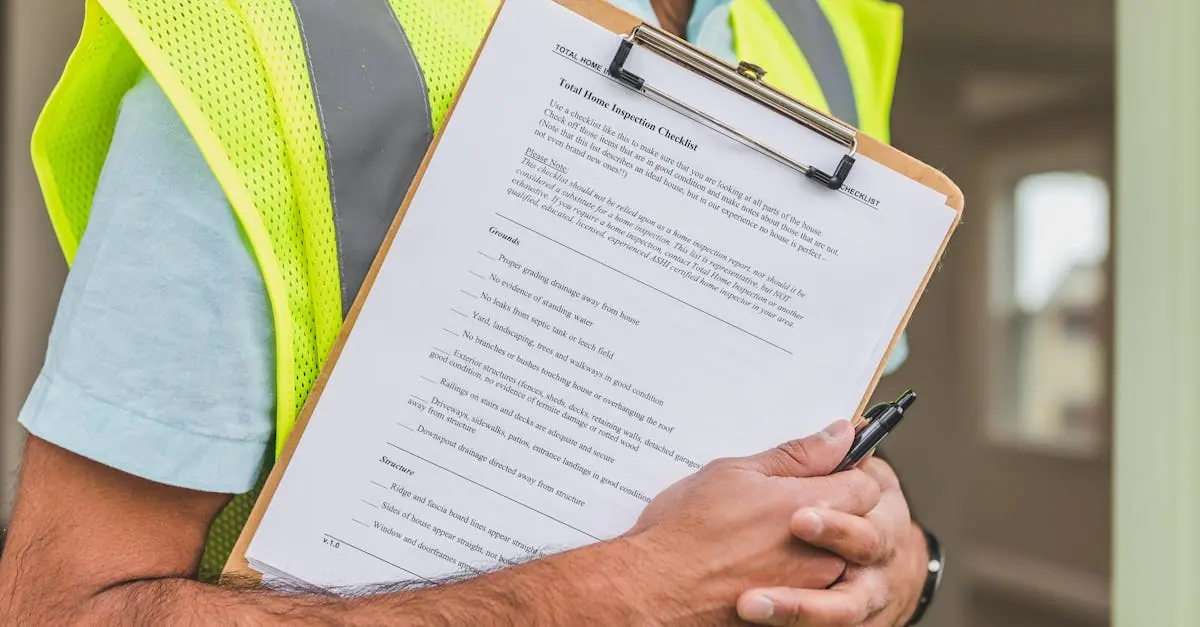Backhoes are the unsung heroes of construction sites, digging, lifting, and moving like they own the place. But like any hardworking machine, they need a little TLC to keep performing at their best. Imagine your backhoe throwing a tantrum mid-job because it skipped its routine check-up. Not a pretty picture, right? That’s why having a backhoe maintenance checklist is essential.
Table of Contents
ToggleImportance Of Backhoe Maintenance
Backhoe maintenance plays a crucial role in keeping equipment operational and efficient. Proper care prevents unexpected breakdowns that can lead to costly repairs and project delays. Regular check-ups enhance the machine’s lifespan and overall performance, ensuring that tasks are completed efficiently.
Failing to perform routine maintenance can result in significant issues, including hydraulic system failures, engine troubles, and structural damage. These problems not only affect productivity but also compromise safety on the job site. Therefore, conducting regular inspections helps identify wear and issues before they escalate.
A backhoe maintenance checklist serves as a vital tool in this process. It outlines essential tasks, such as fluid level checks, filter replacements, and equipment lubrication. This systematic approach aids operators in monitoring the equipment’s condition and addressing potential concerns promptly.
Moreover, thorough maintenance helps retain the machine’s resale value. Equipment that remains in operational condition attracts better offers in the used market. Maintaining a detailed service history also builds trust with potential buyers, showing a commitment to care and upkeep.
By prioritizing backhoe maintenance, companies ensure their machinery remains reliable and efficient. Implementing a routine checklist promotes optimal performance and reduces the likelihood of unscheduled downtime. Emphasizing maintenance not only enhances productivity but also supports a safer work environment for all.
Essential Components Of A Backhoe Maintenance Checklist
A comprehensive backhoe maintenance checklist includes daily, weekly, and monthly tasks that ensure optimal equipment performance and safety on the job site.
Daily Maintenance Tasks
Inspecting fluid levels plays a critical role in daily maintenance. Operators check engine oil, hydraulic fluid, and coolant to prevent machine overheating or malfunctioning. Cleaning the machine’s exterior also remains essential to remove dirt, debris, and grease. Inspecting lights, signals, and gauges ensures that visibility and communication remain adequate. Every operator should examine tires for pressure and wear, as proper tire condition influences stability and traction during operations.
Weekly Maintenance Tasks
Operators perform several key tasks each week to enhance the backhoe’s reliability. Checking and replacing air filters ensures optimal engine airflow, preventing efficiency loss. Inspecting hydraulic hoses for leaks or wear prevents costly repairs and assures safe operation. Testing battery condition while cleaning terminals prevents unexpected power failures. Greasing pivot points and linkages reduces friction, promoting smoother movements. Observing such tasks weekly contributes to the long-term health of the equipment.
Monthly Maintenance Tasks
Monthly inspections focus on deeper maintenance needs that help extend the equipment’s lifespan. Checking drive belts for wear prevents unexpected breakdowns and maintains performance. Additionally, testing the brake system is vital for ensuring proper functionality and safety. Changing hydraulic fluid and filters maintains system cleanliness and efficiency. Evaluating the overall condition of the backhoe assists in identifying wear and tear that can lead to larger issues. Performing these tasks monthly supports ongoing reliability in operations.
Tips For Effective Backhoe Maintenance
Regular maintenance routines contribute significantly to a backhoe’s performance and longevity. Implementing best practices can lead to more efficient operations on construction sites.
Keeping Records
Accurate record-keeping boosts maintenance efficiency. Documenting service history helps track completed tasks and schedules for upcoming maintenance. Such records provide insights into recurring issues that may need attention. Operators can easily assess what components require more frequent checks based on historical data. Records also serve as proof of maintenance for warranty requirements. Consistency in documentation ultimately enhances decision-making for repair and maintenance plans.
Using Quality Parts
Choosing quality parts is crucial for backhoe maintenance. High-quality components ensure compatibility and performance, reducing the likelihood of mechanical failures. When selecting parts, prioritize reputable brands known for reliability. Investing in durable components may increase initial costs but minimizes long-term expenses associated with repairs or replacements. Additionally, using OEM (original equipment manufacturer) parts can enhance the machine’s efficiency and durability. Properly fitted parts maintain optimal performance and contribute to safer operation on job sites.
Common Issues To Look For During Maintenance
Inspecting hydraulic systems regularly is crucial. Leaks often occur in hoses or fittings, leading to pressure drops and decreased performance. Operators need to monitor fluid levels consistently, ensuring they remain at optimal levels to prevent complications.
Checking the undercarriage for wear is also important. Excessive wear on tracks or tires can affect traction and stability. Operators should pay attention to unusual sounds or vibrations, indicating potential mechanical issues.
Monitor the electrical system carefully. Faulty connections can result in starting problems or erratic behavior in controls. Inspecting the battery and its terminals frequently ensures proper power supply, reducing the risk of electrical failures.
Evaluate the cooling system during maintenance routines. Overheating can lead to significant engine damage and reduced efficiency. Regularly checking coolant levels and inspecting hoses for leaks prevents overheating incidents.
Examine the braking system as well. Worn brake pads or fluid leaks can compromise safety and control. Regular checks of brake components help maintain effective stopping power.
Review the engine oil and filter regularly. Dirty oil can lead to increased engine wear and decreased performance. Changing the oil and filter as per the manufacturer’s specifications prevents oil degradation.
Investigating attachment performance is beneficial. Attachments often wear out or develop issues, affecting functionality. Frequent assessments ensure attachments operate effectively, maximizing productivity.
Staying vigilant about these common issues throughout maintenance enhances the backhoe’s reliability. Addressing these concerns promptly mitigates the risk of costly repairs and ensures smooth operations on job sites.
Conclusion
Prioritizing backhoe maintenance is essential for optimal performance and longevity. A well-maintained backhoe not only enhances productivity but also ensures safety on the job site. By following a structured maintenance checklist and addressing common issues, operators can prevent unexpected breakdowns and costly repairs.
Investing time in regular inspections and using quality parts pays off in the long run. Accurate record-keeping further streamlines maintenance efforts and helps identify recurring problems. Ultimately, a commitment to routine maintenance safeguards the equipment’s reliability and supports smooth operations, making it a crucial aspect of any construction project.








